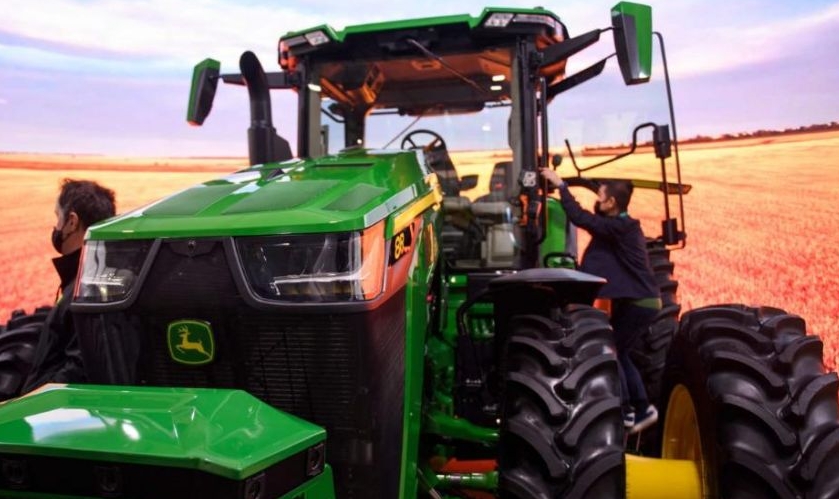John Deere announced the acquisition of an advanced algorithm package from artificial intelligence startup Light.
For those of you wondering when John Deere’s unmanned tractors will really start making their mark on society, the answer is: Already today.
The future.
You won’t see yellow and green tractors rolling down city streets anytime soon. But the timeline for fully autonomous farming is speeding up considerably. Today’s purchase stems from John Deere’s need for speed and precision, but first let’s talk about rapid development.
According to Jorge Jero, John Deere vice president of automation and autonomy, and Willie Pell, vice president of autonomy and new ventures at Blue River Technology (a John Deere company).
They explained that this acquisition would not only speed up the development and deployment of the company’s artificial intelligence technology, but also allow the equipment to literally move faster, safer and without human intervention.
About Light:
Light, the company Deere is partnering with to buy the assets, is a major player in autonomous vehicles. It uses a computer vision approach to self-driving, which allows the AI system driving the vehicle to “see” the world the same way biological systems do.
In essence, Light’s algorithms will allow Deere equipment to use standard cameras to achieve a virtually unprecedented depth perception.
This is similar to the approach Tesla is taking for its “full self-driving” (FSD) system.
In the past, we’ve criticized vision-only approaches here at Neural, but it’s different now. Passenger cars have to drive on busy highways, where the slightest mistake can lead to loss of life.
On the farm, the stakes are very different. Tractors and other farm equipment must be able to identify crops and obstacles to ultimately achieve the goal of optimizing food production.
The current standard solution for autonomy (usually) involves a combination of LiDAR and computer vision. This allows developers to achieve the resolution and depth needed, for example, to teach an artificial intelligence system to “see” a pedestrian walking down the street during a snowstorm.
But that’s not necessarily the best way to do farming. Deere vehicles, for example, often need to be able to see individual weeds in real time as the vehicle moves through bumpy terrain.
A little deeper: LiDAR is expensive and doesn’t really provide the close-up accuracy needed for agricultural operations. It’s nice to see people walking down the street hundreds of yards away, but it’s not very useful for planting individual seeds, eradicating individual weeds or alerting farmers to problems specific to their fields.
Deere’s autonomous vehicles need to be more like robotic workers than simple vehicles. And to do that, they need to focus on recognition with speed and resolution that fits the customer’s needs.
As Pell said:
The ideal sensor is a camera that provides depth with LiDAR quality.
Unfortunately, cameras usually have to be stationary to properly process light for depth. Modern systems overcome this by using image stabilization algorithms.
But it’s one thing to figure out how to compensate for wobbly grip when you pose for selfies, or to teach an AI model to recognize stop signs.
It’s quite another to keep the camera pointed in the right direction when its steel mount bends and vibrates from the force of thousands of kilograms of cars bouncing around on uneven terrain.
And that’s just the tip of the iceberg. Light technology will allow Deere to compensate for all these problems with standard cameras. That means the company can keep equipment costs low by applying advanced algorithms to potentially existing equipment.
Looking ahead: Heero told Neural that the company expects this acquisition to start paying dividends to Deere customers within the next few months. He says the company ultimately intends to reach higher speeds with its current autonomy systems and include more vehicles.
The ultimate goal is to fully automate and optimize farm operations so farmers can spend their time on higher-level management and other purely human efforts.
John Deere is one step closer to fully autonomous farming with its latest acquisition.
John Deere announced the acquisition of an advanced algorithm package from artificial intelligence startup Light.
For those of you wondering when John Deere’s unmanned tractors will really start making their mark on society, the answer is: Already today.
The future.
You won’t see yellow and green tractors rolling down city streets anytime soon. But the timeline for fully autonomous farming is speeding up considerably. Today’s purchase stems from John Deere’s need for speed and precision, but first let’s talk about rapid development.
According to Jorge Jero, John Deere vice president of automation and autonomy, and Willie Pell, vice president of autonomy and new ventures at Blue River Technology (a John Deere company).
They explained that this acquisition would not only speed up the development and deployment of the company’s artificial intelligence technology, but also allow the equipment to literally move faster, safer and without human intervention.
About Light:
Light, the company Deere is partnering with to buy the assets, is a major player in autonomous vehicles. It uses a computer vision approach to self-driving, which allows the AI system driving the vehicle to “see” the world the same way biological systems do.
In essence, Light’s algorithms will allow Deere equipment to use standard cameras to achieve a virtually unprecedented depth perception.
This is similar to the approach Tesla is taking for its “full self-driving” (FSD) system.
In the past, we’ve criticized vision-only approaches here at Neural, but it’s different now. Passenger cars have to drive on busy highways, where the slightest mistake can lead to loss of life.
On the farm, the stakes are very different. Tractors and other farm equipment must be able to identify crops and obstacles to ultimately achieve the goal of optimizing food production.
The current standard solution for autonomy (usually) involves a combination of LiDAR and computer vision. This allows developers to achieve the resolution and depth needed, for example, to teach an artificial intelligence system to “see” a pedestrian walking down the street during a snowstorm.
But that’s not necessarily the best way to do farming. Deere vehicles, for example, often need to be able to see individual weeds in real time as the vehicle moves through bumpy terrain.
A little deeper: LiDAR is expensive and doesn’t really provide the close-up accuracy needed for agricultural operations. It’s nice to see people walking down the street hundreds of yards away, but it’s not very useful for planting individual seeds, eradicating individual weeds or alerting farmers to problems specific to their fields.
Deere’s autonomous vehicles need to be more like robotic workers than simple vehicles. And to do that, they need to focus on recognition with speed and resolution that fits the customer’s needs.
As Pell said:
The ideal sensor is a camera that provides depth with LiDAR quality.
Unfortunately, cameras usually have to be stationary to properly process light for depth. Modern systems overcome this by using image stabilization algorithms.
But it’s one thing to figure out how to compensate for wobbly grip when you pose for selfies, or to teach an AI model to recognize stop signs.
It’s quite another to keep the camera pointed in the right direction when its steel mount bends and vibrates from the force of thousands of kilograms of cars bouncing around on uneven terrain.
And that’s just the tip of the iceberg. Light technology will allow Deere to compensate for all these problems with standard cameras. That means the company can keep equipment costs low by applying advanced algorithms to potentially existing equipment.
Looking ahead: Heero told Neural that the company expects this acquisition to start paying dividends to Deere customers within the next few months. He says the company ultimately intends to reach higher speeds with its current autonomy systems and include more vehicles.
The ultimate goal is to fully automate and optimize farm operations so farmers can spend their time on higher-level management and other purely human efforts.



